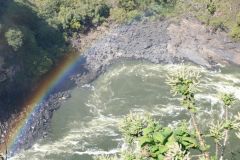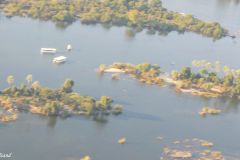This is a collection of Sandalsand’s pictures from Zimbabwe, more precisely the south and the mighty Victoria Falls.
If you look up my articles from Zimbabwe, you will also find a World Heritage Site and a regular travelogue. Before you do, start with these pictures from Zimbabwe.
Afterwards, find all photo galleries on Sandalsand.
Fast facts
Learn about the country on Wikipedia. Here is an excerpt:
Zimbabwe is a landlocked country located in Southeast Africa, between the Zambezi and Limpopo Rivers. It borders South Africa to the south, Botswana to the south-west, Zambia to the north, and Mozambique to the east. The capital and largest city is Harare. The second largest city is Bulawayo. A country of roughly 15 million people, Zimbabwe has 16 official languages, with English, Shona, and Ndebele the most common. It was once known as the “Jewel of Africa” for its great prosperity.
Zimbabwe has one of the richest histories of any nation in southern Africa, and first became a major trade route in the 11th century. During its late iron age, the Gokomere, the Bantu people who would become the ethnic Shona, built the vast city-state of Great Zimbabwe. Built on a wealth of natural resources, Great Zimbabwe flourished financially and culturally from the 14th to 15th centuries, becoming a mercantile powerhouse that controlled the gold, ivory and copper trades with the Swahili coast and various Arab and Indian states. From there, the powerful Kingdom of Zimbabwe was established, followed by the Rozvi, Mutapa and Mthwakazi empires. The Shona and Ndebele peoples, among others, had shaped Zimbabwe into a prosperous and strategically important region when Europeans began to colonise the area in the 1800s.
From company land to colony to freedom
The British South Africa Company of Cecil Rhodes first demarcated the present territory during 1890 when they conquered Mashonaland and later in 1893 Matabeleland after a fierce resistance by Matabele people known as the First Matabele War. Company rule ended in 1923 with the establishment of Southern Rhodesia as a self-governing British colony. In 1965, the conservative white minority government unilaterally declared independence as Rhodesia. The state endured international isolation and a 15-year guerrilla war with black nationalist forces. This finally culminated in a peace agreement that established universal enfranchisement and de jure sovereignty as Zimbabwe in April 1980.




















































